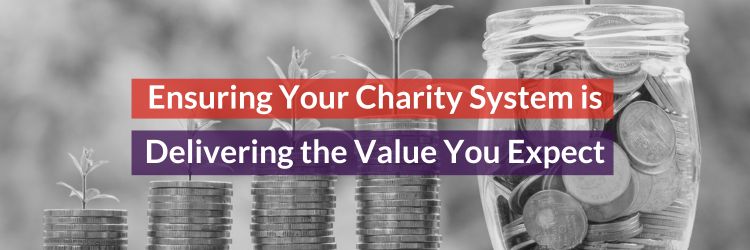
Running a charity often involves using various IT systems and tools to manage your operations efficiently. These IT systems are usually a significant investment of time and resources up front; it is important to ensure that you continue to get the value you need from them. In this blog, we will guide you through a simple process to check that your charity’s IT system is meeting your needs by focusing on your people, processes, and the system itself. Let’s dive in ….
1. What Are Your Charity’s Goals or Aims?
This is the best place to start from, clarifying the goal or aim of your system will help you to understand and benchmark clearly. It might be that you want to improve your medication management processes, conduct and evidence your audit activities, or streamline and effectively record the people you support packages. Being clear on this will help you to understand if the system is working to add value.
2. Ask Your colleagues
The colleagues in your organisation are the face of the organisation, they are the ones who provide the daily interactions both with the people you support and the system itself. They will have first hand experience of what is working and what is causing a barrier in providing the support they want to give. Collect their feedback to understand if they find it easy to use, helps them do their tasks, and is quick to use. This feedback will really help you to understand if your system is adding value.
3. Analyse Your Processes
To meet the needs of the people you support and the industry standards your charity is regulated by your processes and IT systems need to work for you. Some points to consider are:
- Does your IT system simplify day to day tasks?
- Has it improved productivity?
- Does it help you evidence how your day-to-day interactions are supporting the outcomes that the people you support need?
If your processes are getting stuck or are not meeting how you want your work to flow it might not be adding the value, you need.
4. Monitor Key Performance Metrics
To measure the impact the IT system is having in your organisation you should have key performance indicators (KPI’s) in place. Examples of these measures may include time savings on admin tasks that your front-line care colleagues complete, increases in fundraising or evidencing the impact your charity is having. It is worth making sure that you do not have too many KPI’s to monitor and that you select the right ones based on your organisation’s goals. Through tracking these KPI’s you will see if the system is supporting your goals and is contributing to your charity’s success.
5. Analyse the Systems Return on Your Investment
The IT system will have been a significant investment for your charity. It is important to check that you are getting the expected return on your investment. To do this you need to look at comparing the expense of the system against the benefits and improvements it has made in your organisation. If you are seeing the benefits outweigh the costs it is a positive improvement in your organisation.
6. Manage Your System Vendor
Bringing in a new IT system introduces a new relationship to your organisation and one that is essential to be managed to work the best for you. Some organisations benefit from having a system owner who has responsibility for managing the relationship, providing feedback to the vendor, and improving your workflow processes within the system. If this is in place this will support, you to continue to get value from your system.
7. Colleagues Training and Support
Your colleagues may be feeding back to you that they are finding ways of working tricky or are having system difficulties. For some organisations introducing a new system brought new ways of working and seen a massive shift from paper-based recording, to now being digitised. If your colleagues are providing this feedback, it is important to make sure that they had the right level of training and that there is adequate support in place for any queries they have day to day. This investment in your colleagues is essential to ensure that the system is being used in the way you intended to maximise the value you need.
8. Keep Up to Date
Things don’t stand still in the charity sector and the technology and software sector is the same. You need to ensure that your charity system remains up to date, is aligned with your charity’s goals and industry best practices. It is important to evaluate if any of the new system features or upgrades will benefit your organisation positively. This will help to ensure that you continue to get value from your system.
9. Using Your Data
If your system digitises your front-line care colleagues’ processes, then the data held in your IT system can be used to tell you how your organisation is performing. If your system is adding value this data is a natural by-product of your day-to-day interactions. However, if you are still using spreadsheets to capture critical information this is a sign that your IT system is not giving you the value you need.
Conclusion
In conclusion, by managing your charity IT system to deliver value for your people, with easy-to-follow processes and data recording, monitoring your KPIs, keeping your system and processes up to date, you can ensure that your system is continuing to work for you. Remember your IT system should provide the platform to further your charity’s good work and support you to make a lasting positive impact in the communities you support.
If you find your IT system is not delivering the value you expect then you could benefit from our process and system optimisation services. Get in touch with us today to learn more.

